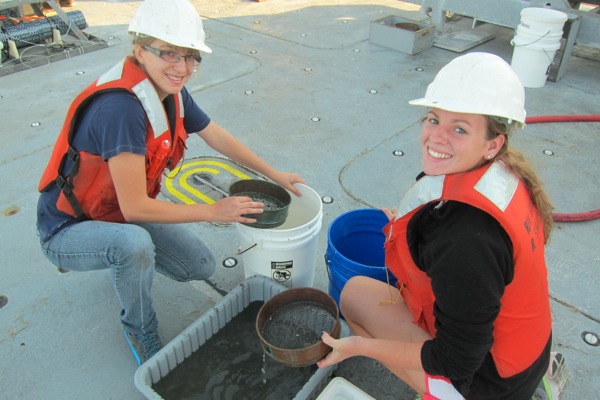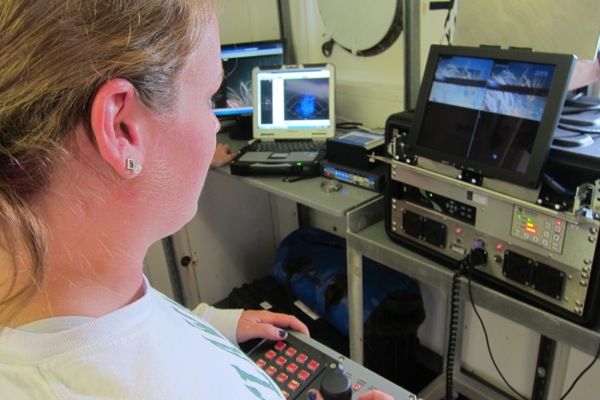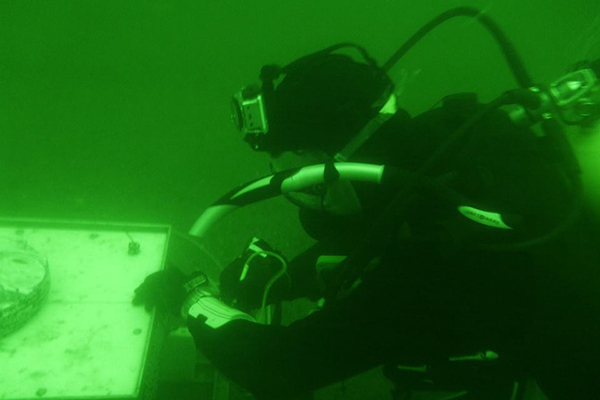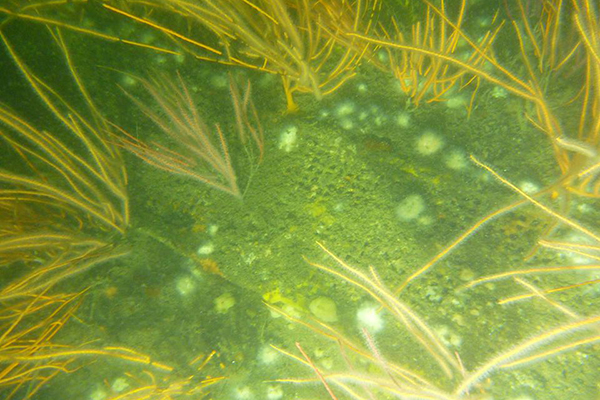Studying aboard
Scientific cruises, fieldwork part of undergraduate experience for CEOE students
11:37 a.m., Sept. 4, 2013--Junior Meghan Owings spent last summer at the beach, but not sunbathing or swimming. She was studying populations of mole crabs, reef-building worms and other marine life, learning different scientific techniques along the way.
“I loved it,” said Owings, who conducted the fieldwork as a summer intern in the University of Delaware’s College of Earth, Ocean, and Environment (CEOE). “It definitely confirmed that I’m in the right field.”
Campus Stories
From graduates, faculty
Doctoral hooding
Owings has the opportunity to continue the work this fall by spending a semester at the Hugh R. Sharp Campus in Lewes, along with a dozen fellow undergraduates majoring in marine science at CEOE. The Semester-in-Residence Program has grown rapidly since the major was introduced two years ago, offering students hands-on research experience and advanced coursework.
Students live in the Daiber Campus Housing near campus and take classes on marine biology, coastal field biology and marine invertebrate biodiversity. Interaction with faculty and graduate students give them exposure to life as a working scientist.
The students regularly get to see underwater robots in action and take part in scientific cruises aboard the University’s research vessel, the Hugh R. Sharp. Owings and other students from the Research Experience for Undergraduates program tagged along with faculty adviser Doug Miller, associate professor of oceanography, on the Sharp for several days late last July.
“It’s fantastic to have undergraduates aboard, as their level of enthusiasm is so high,” Miller said. “Not only is this a great learning experience for them, but it’s very gratifying to us as faculty mentors and instructors. It reminds us of why we went into marine science.”
In addition to studying organisms living at local beaches in the project Owings is assisting with, Miller is examining biodiversity at artificial reef off Delaware’s coast that is made of subway cars. The hard surfaces attract mussels and fish, making it a popular spot for anglers.
From the deck of the R/V Sharp, Miller obtained samples of mud from the seafloor, down about 30 meters, to see what exactly is living there.
Scuba divers on board brought up other organisms from the reef — like yellow sponges and red, coral-like bryozoans — which had previously been hard to identify on video of the reef, Miller said.
The team also for the first time off the Sharp used a new remotely operated vehicle (ROV) to take additional video footage of the reef, letting the students take a hand at maneuvering it through the water.
“One of the neatest things about being on the cruise was the integration of different technologies and that everyone participated fully,” said Mark Moline, director of the School of Marine Science and Policy in CEOE. “Having students piloting ROVs, helping with autonomous underwater vehicle deployments and working on biological samples highlight the versatility of the R/V Sharp and the programs at UD.”
The cruise was the first time in recent memory that researchers scuba dove off the ship, with Moline and Art Trembanis, associate professor of oceanography, entering the water from a small boat. Moline is working to expand diving offerings for students and introduced a new scientific diving course in the Cayman Islands that has already filled to capacity.
Owings, for her part, has already signed up and looks forward to learning how to conduct research underwater in warm, tropical waters. After watching Moline and Trembanis dive last summer in chilly seas, she said it will be a while before she is ready to brave the cold temperatures and swift currents found locally.
“I thought they were very brave, but it looked exciting,” Owings said.
The research cruise was funded with supported from the Office of Naval Research.
Article by Teresa Messmore
Photos by Doug Miller and Mark Moline














